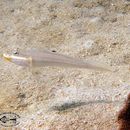Diagnostic Description
provided by Fishbase
Has 2 to 3 blue-bordered red longitudinal stripes on the head that extends faintly on the body, as well as red basal stripes on the dorsal and anal fins, a dark tip on the first dorsal fin, and red ocelli on the caudal fin; characterized further by pale grey body color on back, grading to white on lower side; without filamentous dorsal spines; rhomboid caudal fin, longer than head; length of caudal fin 2.8-3.5 in SL; longitudinal scale series 73-94; ctenoid body scales, becoming cycloid anteriorly below anterior part of fist of first dorsal fin; head or midline of nape without scales; side of nape with scales extending forward above middle to front of operculum; base of pectoral fin scaleless; usually partly scaled prepelvic area in adult; depth of body 5.1-6.2 in SL (Ref. 90102).
- Recorder
- Cristina V. Garilao
Life Cycle
provided by Fishbase
Oviparous, distinct pairing during breeding (Ref. 205). Pairs form upon maturation for breeding purposes (Ref. 56281, 58559). Monogamous mating is observed as both obligate and social (Ref. 52884).
Morphology
provided by Fishbase
Dorsal spines (total): 7; Dorsal soft rays (total): 12; Analspines: 1; Analsoft rays: 12
- Recorder
- Cristina V. Garilao
Trophic Strategy
provided by Fishbase
Inhabits shallow coastal sand and rubble flats, often near mangroves (Ref. 48637). Occurs in areas of fine sand in shallow lagoon reefs. Adults occur in pairs while juveniles were often seen in small groups. Feeds on small invertebrates by sifting mouthfuls of sand.
- Recorder
- Drina Sta. Iglesia
Biology
provided by Fishbase
Inhabits shallow coastal sand and rubble flats, often near mangroves (Ref. 48637). Occur in areas of fine sand in shallow lagoon reefs. Adults occur in pairs while juveniles were often seen in small groups. Feed on small invertebrates by sifting mouthfuls of sand. Monogamous (Ref. 52884). Oviparous (Ref. 205). Breeding pairs are commonly found sharing a single burrow (Ref. 56281).
- Recorder
- Estelita Emily Capuli
Importance
provided by Fishbase
aquarium: commercial
- Recorder
- Estelita Emily Capuli

